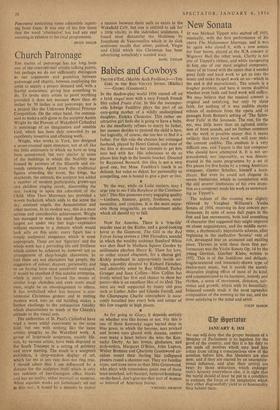Church Patronage
Tim matter of patronage has for long been one of the conventional artistic talking points, but perhaps we do not sufficiently distinguish in our arguments and grumbles between patronage and charity, between employing the artist to supply a proper demand and, with a fearful conscience, giving him something to do. To invite sixty artists to paint anything provided it does not measure Imre than 40 inches by 50 inches is not patronage, nor is a project like the Unknown Political Prisoner Competition. On the other hand, the commis- sion to make a crib given to the sculptor Austin Wright by the Provost of Wakefield Cathedral is patronage of an imaginative and sensible kind, which has been duly rewarded by an excellently inventive and affecting work.
Wright, who works in York, has designed a seven-roomed open structure, not at all like the little enclosures to which we have so long been accustomed, but very similar to some of the buildings in whiei the Nativity was housed by painters of the fifteenth and six- teenth centuries. Apart from the traditional figures attending the event, the kings, the shepherds, the animals, the sculptor has added a number of modern participants, grown-ups ,and children singing carols, discovering the star, looking in upon the adoration of the Child. Miss Theo Moorman has provided a woven backcloth which adds to the scene the sky, exultant angels, the Annunciation and other motives. In its modest way, this is a most serious and considerable achievement. Wright has managed to make his small figures—the largest are under two feet high—expressive without recourse to a rhetoric which would look silly on this scale; every figure has a simple sculptural eloquence which is most appropriate, These arc not 'figurines' and the whole work has a pervading life and liveliness which cannot be achieved by however apt an arrangement of shop-bought characters. In fact these are not characters but people, the suggestion of colour, drapery, personality and so on having been most sensitively managed. It would be excellent if this notable enterprise. which is surely not beyond the means of similar large churches and even some small ones, might be an encouragement to others. It has revitalised what has become a con- ventional Christmas gesture and in putting modern work into an old building makes a further challenge to the antiquarian timidity which characterises so much of the Church's attitude to the visual arts.
The authorities of St. Paul's Cathedral have tried a more artful experiment in the same field, but one with nothing like the same artistic integrity as the Wakefield work. A group of large-scale sculptures, mainly life- size, by various artists, have been disposed in the South Transept in a setting of greenery and straw matting. The result is a sculpture exhibition, a shop-window display of art, which for me at any rate does not ring true.
should admit that I am influenced by a distaste for the sculpture itself which is only too redolent of nco-Georgian office blocks and has no reality, either mystical or material. When separate works are fortuitously set out in this way, it would be a mistake to expect
a tension between them such as exists in the Wakefield Crib, but one is entitled to ask for a little vitality in the individual sculptures. I found most distasteful the Madonna by Josephone de Vasconcellos which in its slick sentiment recalls that other, painted, Virgin and Child which this Christmas has been advertising somebody's scented soap.
BASIL TAYLOR


































 Previous page
Previous page